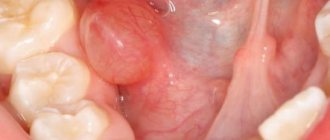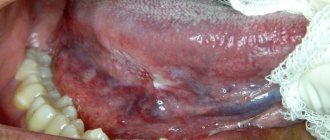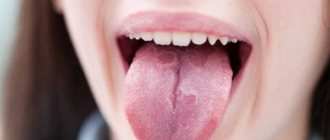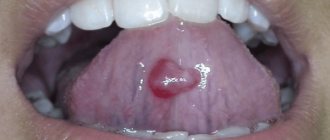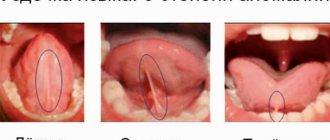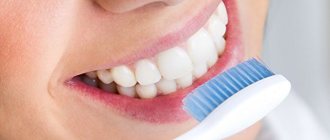Zones of the tongue: correspondence to their internal organs
To determine diseases by the condition of the tongue, you need to take into account that it is conventionally divided into several zones that are responsible for certain organs within the body. During a tongue diagnosis, the doctor will definitely look at the location of the changes. Ancient practices divided all areas of language into five primary elements:
- back - Water;
- center - Earth;
- sides – Tree;
- the area between the tip and the center is Metal;
- tip – Fire.
Functions
The anatomy of the tongue allows it to cope with several functions:
- Accelerates the regeneration of all damaged areas of the tongue and oral cavity.
- Helps in the absorption of various medications.
- Protects against various infections and viruses.
- Makes it possible to distinguish a huge range of tastes, temperature and even pain.
- Helps you speak clearly, understandably, and even imitate certain sounds.
We’ll talk about what helps us pronounce clear sounds.
The human tongue is an unpaired muscular outgrowth located in the oral cavity and does not contain bones. The organ is responsible for the perception of taste and is directly involved in the mechanical processing of food. After food enters the oral cavity, it mixes with saliva. With its help, the digestive process begins, since it is it that ensures the act of swallowing and the further movement of food. Important functions for the human body are salivation and chewing activity.
In addition, the tongue is endowed with high tactile sensitivity. This feature makes it possible to feel the touch of various objects on the shell of the organ. The anatomical structure and functions of the tongue allow a person to speak clearly. Thanks to this, people are able to express thoughts and utter full-fledged phrases, forming communication in society.
The role of the organ is especially important when feeding newborns with mother's breast milk. Due to the absence of bones, the baby easily latch onto the mammary glands. In the fetus during intrauterine development, organ formation begins at 4-5 weeks of pregnancy. Also, the state of the tongue is used to judge the development of pathological disorders in a person’s body at any age. Doctors take into account not the length of the tongue, since it may differ between people, but its mobility, color and the presence of plaque.
Anatomy and functions
The human tongue by its nature is a muscular organ that does not have bones. On top it is covered with a mucous membrane. Tasks and functions it performs:
- participates in the functioning of the speech apparatus;
- determines the taste of the food a person eats;
- is part of the digestive system - it performs primary processing of food, mixes it and forms a food bolus, which pushes further into the esophagus.
The structure of the language is simple but interesting. This organ is divided into two parts - the back - the root and the front - the body. The upper surface is also called the back and has a velvety structure.
The tongue is covered with papillae, which are divided into 4 groups responsible for recognizing tastes. That is why, with a burn or other injuries to the tongue, a person temporarily loses the ability to perceive one or more tastes.
Taste buds
There are 4 types of taste buds in the mucous membrane of the tongue.
The filiform and conical papillae of the tongue are the most numerous; they cover its entire anterior part. They are not taste buds, but serve the sense of touch, pain and temperature. In cats, such papillae are especially developed and resemble tiny hooks. This makes their tongue as rough as sandpaper and allows them to rip off pieces of meat from the bones. You can notice this feature in the domestic cat.
The mushroom-shaped papillae of the tongue really resemble mushroom caps in their shape. They are recognized as taste buds. Most of them contain so-called taste buds, consisting of supporting cells and taste receptors themselves. When a substance dissolved in saliva enters the chemoreceptor through a pore, it transmits a signal to the brain. If there are enough such signals, a person feels taste. The fungiform papillae are specialized for the perception of sweet taste.
The circumvallate papillae are the largest. Their name is associated with their shape - they are surrounded by a moat. It is assumed that they perceive bitter taste.
Leaf-shaped ones determine the sour taste. Their accumulation can be found along the edges of the tongue.
How to properly examine your tongue?
A person's tongue reflects his internal organs. A change in shape, color, as well as the appearance of plaque indicate that you urgently need to sound the alarm and seek help from a doctor who will conduct a diagnosis. Determination of the disease by the tongue is carried out on an empty stomach or two hours after eating and drinking. When conducting diagnostics, the doctor adheres to the following simple rules:
- the inspection is carried out in diffuse daylight or in a room with fluorescent lamps;
- the patient should extend the tongue as far as possible, and if it is not possible to carefully examine the root, then a spatula is used;
- in case of nasal congestion or other pathologies, the patient can breathe through the mouth, which means that the surface of the tongue will be dry; in this case, a second examination is carried out after rinsing the mouth;
- to observe the dynamics, it is better to carry out language diagnostics immediately after a night’s sleep; photos and descriptions will help to better understand the diagnosis;
- It is worth remembering that some foods, for example, blueberries and raspberries, can change the color of the tongue and plaque, so it is better to postpone the examination and carry it out at a time when the patient is ready;
- The color of the tongue can be changed by medications, so the doctor should interview the patient before the examination to exclude diagnostic errors.
Determining the optimal age
Girls and boys start kissing literally in kindergarten. They believe that the sooner you start a relationship with kisses, the better. When should you kiss for the first time, what period is the most favorable for this?
The first real kiss remains in memory forever. According to statistics, this romantic event occurs between the ages of 12 and 16. Usually girls kiss earlier. They decide to have their first kiss because they do not want to be worse than their peers, but they often cause themselves psychological trauma, since the first kiss must be accompanied by real feelings.
Let's look at different periods of life and the influence of a kiss on people:
- 4-6 years. Parents kiss their children, so kids also express their affection in kindergarten. These kisses are not considered serious, and memories of them are often erased.
- 7-9 years. At the first holidays, for example, school discos, children can kiss. This event has romantic overtones.
- 10-12 years. Children develop a physiological interest in the opposite sex. They may already feel attracted, but adult kisses are not yet available to them.
- 13 years old. This is a special age when puberty occurs, and the most active contact of sympathetic partners is expressed in a kiss.
- 14-16 years old. At this age, almost everyone already kisses, as they experience physical attraction and great sympathy.
- 17-18 years old. This is exactly the age when kissing passionately with tongue. It is recommended to start learning gentle touches now.
- 20-30 years. If a person kisses for the first time at this age, it means that he has certain deviations in life.
READ Exciting massage: how to please the woman you love
What does a healthy tongue look like?
The mucous surface of someone who does not have chronic or acute diseases has a soft pink tint and is covered with a whitish coating, similar to that which appears on tooth enamel. In a healthy state, the papillae are clearly visible, their number is very large, and there are no visible defects on the surface. The tongue should not be swollen, with spots, defects in the form of warts, inflammation or other damage.
A change in color, hardness, shape or size indicates that diseases are appearing in the body, and you can determine which disease is taking place by the location of the defects or their type. Thus, Chinese doctors diagnose health problems by where exactly the damage is located, what color the surface has become, and how the plaque has changed. Before making a diagnosis, the specialist takes into account all aspects, from the shape of the organ to the intensity of salivation.
Important! Before performing a visual examination, the patient should rinse his mouth thoroughly and brush with a brush so that the clinical picture is not distorted. A person’s tongue can change color, for example, after eating food that has specific natural or artificial colors.
A healthy tongue without any pathologies should be pink and have a fold that runs along its entire surface. Also, the tongue in its normal state is soft to the touch and does not cause discomfort if it is moved while talking or eating. Taste buds are usually clearly distinguishable and pronounced.
A small amount of white coating is normal for a healthy tongue. Its quantity may vary depending on the season. Also, the presence of a thin whitish coating indicates a minor pathology that develops slowly and has a local location.
Plaque can lead to the appearance of:
- caries;
- gingivitis;
- gum pathologies;
- candidiasis.
Problems with the gastrointestinal tract, food allergies and lack of vitamins are the root cause of the formation of yellow or white plaque. Plaque thickening may indicate diseases, including chronic ones, requiring immediate consultation with a specialist.
Other Important Points
If you want a truly unforgettable kiss, then consider some more important points. Guys and girls tend to worry; they don’t know how to handle languages. Even having memorized the basic movements, they continue to worry. In addition to studying the description of a kiss with a tongue, we will deal with the main fears of young people:
READ Prelude: what is it and why is it so important
- Before the first contact, people feel shy and nervous. It is necessary to create conditions that would help you relax: a romantic atmosphere, dim lighting, a beautiful place.
- Fear of failure. For everything to go well, you need to be well prepared. To do this, you should study the techniques and basic rules. It is important to understand that everyone once started and completed this enjoyable task perfectly.
- Uncertainty about the companion. If you doubt the person you want to kiss, he causes mistrust, then take your time. Even if you've never had your first intimate moment, it's okay. Listen to your feelings, don’t do things you’ll regret later.
- When kissing, you should trust your chosen one. He can tell you how to kiss on the lips correctly, and he will guide you with his tongue.
Stages of diagnostics
Diagnosis and identification of the disease by language (photos will help you navigate) will be more effective if you follow all the stages of its implementation:
- Study the structure and density of the tongue. All changes in shape, color and mobility are taken into account. All these criteria help to correctly assess the functional state of all body systems, and especially the blood.
- Study of plaque. It is graded by color, thickness, shape and appearance. It is also important to determine whether the tongue is dry or wet.
- Stains. The main thing is to exclude those that appeared after taking medications or food. All other changes should indicate the development of a particular pathology.
- Roughness and other criteria.
And now - in more detail about all stages of diagnosis, so that you can better determine which organ has failed.
Eastern medicine considers this organ as a point of passage for a number of important energy channels. The corresponding meridian shows the state of the organ that is connected to it. According to the principles of the Five Elements theory, there is the following relationship between language areas and internal systems:
- The tip is connected to the heart and lungs.
- The lateral sections indicate the condition of the liver and gall bladder.
- The dorsum is connected to the spleen and the gastrointestinal tract.
- The condition of the root indicates the level of kidney health.
In the event of problems affecting internal organs, the tongue reacts first to the change. Based on the condition of this part of the body, a competent diagnostician can not only determine what kind of disease is being discussed in a particular case, but also determine whether it is chronic or not and at what stage it is.
You can make a diagnosis based on the tongue by paying attention to changes in shade. They are associated with diseases as follows:
- Crimson is a sign of poisoning with an increase in temperature, the entry of a severe viral infection into the human body, which may indicate a severe stage of pneumonia.
- A bluish or bluish tint is an indicator of defects in the heart. This color may also indicate an increased risk of heart attack in middle-aged and older people.
- Red is a symptom of heart or lung problems, blood disorders or infections. The more intense and dark the shade, the more difficult the patient’s situation. If there are alternating white and red spots on the tongue, this may indicate scarlet fever.
- Purple color – chronic blood diseases and lung problems at a late stage.
- Black is a sign of possible cholera infection.
- A whitish surface indicates anemia and severe exhaustion. If a person experiences that the lower part of the organ becomes white, this indicates pathological changes in the liver or gall bladder.
Also, changes in shade may indicate problems with energy channels, improper flow of energy, which provokes a general deterioration in well-being and individual organs. Diagnostics of the body makes it possible to discover what disorders are being discussed in a particular case. So, dark brown is a symptom of vata dosha disorders, white indicates problems with kapha, and a red tint is a sign of pitta disorders.
We suggest you read: The tip of the tongue twitches – Oral health
What happens with gastritis?
The most common stomach disease is gastritis. The following types of gastritis are distinguished:
- With low acidity - hypoacid.
- With high acidity – hyperacid.
Hydrochloric acid in hypoacid gastritis is produced in small quantities. The main symptoms of the disease are:
- heartburn;
- belching with the smell of a rotting egg;
- pain in the stomach;
- problems with “stool”, flatulence is possible;
- there is a “metal” taste in the mouth;
- the tongue swells, the papillae of the tongue become inflamed;
- The burning sensation intensifies and dry mouth appears.
In the case of hyperacid gastritis, severe irritation of the gastric mucosa occurs. The coating on the tongue becomes white, the consistency is dense, localized in the center. The tongue becomes rough, the papillae enlarge, and salivation increases.
Signs of pathologies according to the characteristics of the tongue
In addition to the shade, a specialist diagnosing health pays attention to other signs, including the thickness, amount and color of plaque on the surface. Changes may be as follows:
- If the plaque is thin, this may indicate the onset of the disease; as it progresses it thickens. Chinese medicine specialists pay attention not only to the thickness, but also to the viscosity of plaque and the intensity of the change in condition.
- An unhealthy coating on the base of the tongue indicates problems with the gastrointestinal tract.
- The presence of plaque on the back of the organ indicates intoxication of the large intestine, but if it is in the center, this indicates the presence of harmful substances in the small intestine and parts of the stomach.
- If the plaque has a greasy, loose structure, this indicates stagnation and poor digestion of food, and excessive accumulation of mucus.
- The condition of a person’s tongue can be worsened by whitish deposits on the surface with cracks on the sides: they indicate possible gastritis, an ulcer of the gastrointestinal tract. The presence of gastroenteritis is indicated by a gray tint of deposits, which is often accompanied by bad breath and a constant metallic taste.
- If a thick white coating has formed on the sides and in front, the doctor may diagnose lung disease. The appearance of formations in the posterior third indicates problems with the kidneys, and if they cover the entire surface, most likely the cause is dysbacteriosis, stomatitis or the development of thrush (in women).
- A black coating that is difficult to separate from the surface indicates a deficiency of B vitamins: this disease is known as pellagra. At a later stage, it changes color to red with a glossy texture. Dark brown formations indicate lung disease. In general, darkening can indicate dehydration and digestive problems.
Diagnosis by tongue in Chinese medicine also requires paying attention to other changes in the appearance of the organ. For example, if a line runs through the center of the tongue, this indicates the presence of excitation in the spine, excessive tension caused by physical or psychological reasons; During diagnostics, a curvature of the pillar may be detected if the line is deformed.
Teeth prints on the tip or sides indicate problems with digestion of food, hidden neuroses. If a person has a curved tongue, his health may worsen due to an imminent ischemic attack or stroke, or problems with the functioning of the cerebellum. Excessive dryness indicates the possibility of the appearance and development of diabetes, and trembling indicates possible nervous and mental disorders.
Chinese methods for determining diseases by the state of the tongue, used in modern clinics, are based on a combination of the practical experience of oriental medicine with the knowledge of modern science about the structure of the body, the functioning of internal organs and their pathologies. The effectiveness of such methods is confirmed by additional testing methods that are aimed at studying the condition of a specific part of the body.
If all organs in the human body work without failure, then the tongue will have a pale pink color and a smooth surface, covered with an even transparent film of salivary secretion. The papillae are clearly visible, the central fold is smooth and straight. Any changes in the form of plaque or marks already indicate that there are malfunctions in the body.
You should also take into account the fact that changes in the tongue can be provoked by the foods you eat. Therefore, before conducting a tongue diagnosis, it is recommended to refrain from eating and drinking two hours before the examination.
Motor innervation of the tongue
The tongue is innervated by 5 of the 12 cranial nerves. The hypoglossal nerve (XII pair) is responsible for the motor innervation of the tongue. Its motor pathway has two links. Its central neuron can be found in the cerebral cortex, in the lower third of the precentral gyrus - as well as for other motor nerves innervating the organs of articulation.
In this gyrus, the motor pyramidal tract begins, which ends in the spinal cord, if we are talking about the innervation of the muscles of the limbs and torso, or in the nuclei of the cranial nerves, if the muscles of the head and neck are innervated. This path is named pyramidal due to the pyramidal cells. This is the shape of neurons in the cortex that control movements. The diagram of the human body on this gyrus appears upside down, so neurons in its lower third are responsible for the functioning of the tongue.
The next neuron is located in the nucleus of the medulla oblongata. The nerve innervates the tongue's own muscles, and in addition to them, those of the skeletal muscles that move the tongue forward and up, down and back. For example, the genioglossus muscle. When the peripheral nucleus of this nerve is damaged, it pushes the tongue onto the paralyzed side.
However, not all muscles of the tongue are controlled by the hypoglossal nerve. The vagus nerve (X pair) is also involved in the innervation of the tongue. It is called wandering because it permeates a huge number of organs, and its branches can be found almost everywhere. This nerve also powers the parasympathetic nervous system.
And the innervation of skeletal muscles is carried out by 2 of its branches: the superior laryngeal nerve controls the geniohyoid muscle, and the lower laryngeal nerve controls the hypoglossus and styloglossus muscles. The central neuron of its pathway can also be found in the lower third of the precentral gyrus. And the peripheral one is also in the medulla oblongata, where the nucleus of the vagus nerve is located.
The central neurons of the sensory nerves are located in different areas of the cortex depending on their specialization. General sensitivity is represented in the somatosensory zone - in the postcentral gyrus of the parietal lobe, also in the lower third. And the taste is represented in the taste cortex just below.
The tongue is innervated in the anterior 2/3 by the lingual nerve. It is a branch of the mandibular nerve (III pair). It provides general sensitivity - touch, pain, heat and cold in the front of the tongue, as well as the mucous membrane of the floor of the mouth, the front of the lower gum, palatine arches and tonsils. The glossopharyngeal nerve (IX pair) is responsible not only for general but also taste sensitivity of the posterior third of the tongue.
And taste sensations from the anterior 2/3 of the tongue are transmitted by the tympanic chord - a branch of the facial nerve (VII pair). It also innervates the salivary glands. Circuits of sensory neurons are more complex than those of motor neurons. Typically the circuit includes 3 neurons. The first of them is located in the nucleus of the corresponding nerve, the next is in the thalamus, the central one is in the somatosensory and gustatory cortex. This applies to all the above sensory nerves.
All the colors of the rainbow in your mouth
Most often, it is the coating on the tongue that indicates that some problems have occurred in the body. To determine which organ is not working correctly and at what stage of development the disease is, you should take a closer look at the color of the plaque. Shades can be different: from white to bright red. What does the shade of plaque on the tongue indicate:
- yellow – diseases of the stomach and intestines, liver failure, smoking;
- blue indicates kidney failure;
- blue and violet - heart and lungs;
- black – chromogenic fungal infection, acidosis;
- gray indicates chronic forms of pathologies of the stomach and intestines;
- deep red indicates malfunction of the heart, blood vessels and blood disease;
- burgundy indicates acute infections;
- reddish indicates infection or inflammation;
- white indicates dehydration, infection caused by a fungus, or a cold.
Photos of cracks, ulcers and color saturation will also help make the correct diagnosis of a person’s tongue.
Everyone knows that by the color of the tongue one can easily determine that something is wrong with the body, since some diseases are “reflected” on it by the characteristic color of the plaque. The most common of them:
- measles or flu, high fever - burgundy coating;
- lack of nutrition, anemia, heart failure - pale tongue;
- diseases of the blood or respiratory tract - purple plaque;
- problems with the gastrointestinal tract, smoking, jaundice - yellow or gray plaque;
- diseases of the liver, spleen, dysentery, abscesses, advanced viral diseases - black plaque;
- kidney disease - blue plaque;
- blood circulation disorders, heavy metal poisoning, scurvy - blue plaque;
- dehydration, fungal infection - white tongue;
- diseases of the oral cavity - dark brown plaque.
That is why it is important to pay attention to details, as they can tell more about health than the person himself.
The presence of a coating on the tongue of an unhealthy color indicates that changes are occurring in some specific organ or even group; there is a problem that requires attention and medical intervention. In order to understand exactly what is happening, you need to know the specific location of the plaque.
Most often, the color of the tongue and plaque differs, which makes it possible to determine the approximate system of organs in need of treatment.
The thickness of the plaque shows the severity of the problem - the thicker it is, the faster changes occur that are harmful to human health.
If the white coating forms in a thick layer, the gastrointestinal tract suffers, and the likelihood of constipation increases. If it is located in a thin layer on the tip of the tongue, the main problem is gastritis. At the same time, a thick layer on the tip of the tongue indicates complications with gastritis or that the disease has become chronic.
If plaque is located at the root of the tongue, then this is the first sign of inflammatory processes in the intestines. If the plaque is gray in color and concentrated at the root of the tongue, then one can judge about chronic diseases of the intestines and stomach, such as high acidity.
Plaque can also be yellow or black - this is a reason to think about the health of internal organs, including:
- spleen;
- gallbladder;
- liver.
A sign of serious pathology is a long period of persistence of plaque on the tongue. If the plaque lasts only a few hours or a day, then in this case it is necessary to take into account the fact that there is an imbalance in the microbial balance in the oral cavity.
Most likely, the cause is gastrointestinal problems, so consultation with a specialist in this field is necessary to prevent the situation from worsening.
It is important to remember that a white coating on the tongue may also indicate respiratory diseases, such as pneumonia.
This disease can be identified by the gradual darkening of plaque and its location along the edges of the tongue and on its front part. If darkening does not occur, then with a similar placement of plaque, we can talk about pneumonia.
The tongue does not always have a perfectly flat surface. You can often see cracks on it. If there are many of them, then such a language is called “geographical”; it may indicate that problems with the gastrointestinal tract have become chronic, as well as that mental disorders are possible.
We suggest you familiarize yourself with Toothpastes harmful to health
In addition, many cracks in the tongue indicate:
- disturbances in the functioning of parts of the brain;
- presence of an allergic reaction;
- somatic disorders in the body.
Also, if there are cracks in the tongue, you should consult a doctor, as pathology of the hypoglossal nerve is likely.
It can be recognized if, along with cracks, there is a deviation of the tongue to the side. Based on the location of the cracks, the side on which the organs are under stress or where there is a disease is diagnosed.
For example, if they are located exactly in the middle of the tongue, then there is a high probability of problems with the spine. A curved crack located at the root of the tongue indicates problems in the lumbar region, at the tip of the tongue, or in the cervical region.
How to kiss with tongue correctly?
Take it gradually.
Such mastery requires smoothness and does not tolerate haste. This is why French kissing is not started right away . At first, it’s better to just gently press your lips to his/her lips, lightly clasping one of them with your two.
Then it’s time for a “test” - a test of readiness for the next step (see paragraph “Careful Test”).
If the green light is given, you can gently begin to move your tongue around the mouth. First, only the tip is activated, then the back is connected. It is important that the movements are smooth, unsweeping, and sliding.
Experiment.
Using the tongue opens up new possibilities for pleasure. To stop at just one point or movement is a great loss.
There are several varieties of this technique. Here are just a few of them:
- stinging - during a simple kiss, push the tip of the tongue several times between the lips of a guy or girl;
- inflaming - licking movements are concentrated only on the lips;
- mill - contact of tongues, performed in the form of circular rotations;
- royal - touching the teeth (the inner part of the lips is automatically touched);
- exquisite - a brief touch to the sky.
But even that's not all. You can not only stroke your partner’s tongue (along, in a circle, across, chaotically), but also lightly bite, suck, even tickle, making quick but short movements with the tip.
Find the right points.
The most sensitive and successful points are the outer and inner zones of the lip (especially the upper one), and the frenulum of the tongue. The tip, back of the tongue, and cheeks are also good places for exposure.
But what is definitely better not to do is tickle the palate or try to reach the root of the tongue. At best, the kisser will simply move away or redirect the other person's tongue with his own. In the worst case, a person will experience unpleasant sensations up to the urge to vomit.
Take the compatibility test
Don't forget about posture and movements.
To use such a passionate expression of feelings, while freely lowering your hands and taking a static position, is somehow wrong.
Girls can bend a little in the lower back, pressing their breasts to their chosen one.
- You can run your fingers through your man's hair.
- Running your hands over his shoulders, back, neck, or placing them on his torso is a great idea.
- If an even more intimate continuation is planned, it would be good to put your hands under his shirt/T-shirt/sweater.
A guy can hold his partner tightly to him, stroke her waist and back.
- The neck is a real erogenous zone, so you can place your palm on it and gently squeeze it.
- A girl will like it if they gently stroke her cheek during a kiss.
- Running his fingertips along the hollow between the collarbones, a man will certainly cause a pleasant shiver in his lady.
Catch the couple's reaction.
Timely response to retaliatory actions can also enhance the positive effect of a kiss.
It's simple: if a person pushes away, moves away, or tries to change the position, it is better to stop the current action or replace it with another. Exactly the same and vice versa.
If a partner constantly repeats some movement or tries to encourage his partner to do it, then he likes it. However, shyness or awkwardness does not allow you to express everything openly. You can try to trust your beloved person and experience something new. Mirroring the steps taken will also work.
Finish correctly.
You can't stop abruptly. This decision leaves a feeling of incompleteness. It’s the same as if a skilled artist with enormous potential suddenly gave up painting a painting halfway through the process.
The completion of a technique mirrors the beginning:
- smoothly move your tongue back along the affected points;
- lightly lick the lips or their contours;
- completely stop using your tongue;
- continue kissing in a simple way, slowing down the pace, weakening the force of the touches, until the lips barely touch each other;
- carefully move away from your partner.
Then it is better to give a compliment, for example: “Your lips are so soft/sugar/delicate” or “Mmm, that was magical, you are a good kisser.” If everything went well, of course.
If you didn’t like something about his/her kiss , you can try to correct it immediately. To do this, use phrases constructed according to the following scheme:
- “I liked the fact that you...” (softly biting her lip, stroking her neck, combing through her hair);
- “It was nice/interesting/healthy/sweet”;
- “You know what would be even nicer? If you…” (she hugged me by the neck, sometimes whispered tenderness) or “But this kiss would be even better if you…” (she first swallowed her saliva a little, slightly reduced the pressure);
- “Let's try this? What do you say?".
It is important to express goodwill and smile sincerely, then a person will adequately perceive veiled criticism. After offering your option, you can reach for a new portion of pleasure.
Shape of the tongue: what diseases will it indicate?
In addition to the color of the tongue, when making a diagnosis it is also important to pay attention to the shape. The following changes can indicate pathology:
- altered relief will indicate a lack of vitamin B in the body;
- the midline is curved - this means that the patient has problems with the spine;
- if the tongue is enlarged and swollen, then this indicates diseases of the stomach and intestines;
- excessively thin language indicates that metabolic processes are disrupted and dysfunction of the hematopoietic system is observed;
- if bulges are observed in the anterior zone, then this is a signal that the bronchi and lungs should be checked;
- the tongue is long and the tip is significantly enlarged - this indicates heart failure;
- A thickened tongue will tell you about liver failure and diseases of the digestive system.
Diagnosis of a person’s tongue will be more accurate if you also pay attention to the spots, including the smallest ones.
How to clean your tongue and take care of your mouth
The presence of a white coating on the tongue and bad breath causes a number of inconveniences to a person. These factors are also favorable conditions for the development of bacteria. This is why it is necessary to maintain personal hygiene.
- The tongue and cheeks should be cleaned daily using toothbrush attachments or a special part.
- You need to clean carefully and carefully, so as not to injure the papillae, clean the tongue in the direction from the base to the edge.
- If the coating on the tongue is hard, then you can get rid of it with the help of softeners. This may be a solution of soda or other special products that are sold in pharmacies.
- It is necessary to brush your teeth 2 times a day. This will help get rid of bad breath. To neutralize the odor, you can use special mouth fresheners.
- After cleaning, you need to rinse your mouth with water.
- Warm mineral water and rinsing with chamomile or sage will help get rid of the bitter taste.
- You should use mouthwash after every meal.
There are many different rinses based on medicinal herbs and plants. Chewing gum, aerosols, and sprays will also help cope with the unpleasant odor.
Traditional medicine can also help you find out how to get rid of the above problems. The following recommendations will help you cope with unpleasant bitterness:
- Drink a glass of flax seed infusion once a day. It will help cope not only with bitterness, but also temporarily eliminate other unfavorable symptoms of gastritis.
- You can use corn silk. 1 spoon of this product is poured with boiling water and allowed to brew for several hours. The finished infusion should be drunk 4 times a day in small portions.
Important information: What is hemorrhagic gastritis and methods of treatment
Following a daily routine will help you cope with dryness. The last meal should be no later than 5 hours before bedtime. You need to increase your daily fluid intake, it is recommended to drink 1 glass of water before each meal (half an hour before), warm mineral water will be very useful.
Strong green tea will help relieve the burning sensation. 1 tbsp. l. pour a glass of water and let it brew for 1 hour in a closed container. You need to rinse your mouth with the resulting solution every 5-6 hours.
Inflammations that affect the oral cavity and tongue do not always indicate that the organs in the body are not working properly. In some cases, they may indicate independent illnesses.
If an unpleasant burning sensation or a feeling of the presence of a foreign body appears in the mouth, the tongue swells and becomes red, salivation increases, taste changes, speech becomes difficult, food causes discomfort - all this indicates the development of glossitis (inflammation of the tongue). This disease can come in different forms, but all the symptoms described apply to any of them.
Types of kisses
Lip touching can be done in many ways. Each type of kiss has its own shades, technique and intensity.
The most popular and interesting of them:
READ How to excite a guy by correspondence: secrets of female seduction at a distance
- Gentle. Run your finger over your partner's mouth, whisper a declaration of love to him and kiss him tenderly.
- Strawberry. This type contains a surprise - discreetly put the strawberry in your mouth and pass it to your partner when kissing. It will turn out romantic and erotic.
- Edible. Before caresses, the lips are smeared with something tasty. Such kisses will make the relationship original.
- Playful. The man bites his partner’s lips, the girl actively participates, using the caress of her tongue.
- Passionate. The partner showers kisses on the body of the loved one, including the face. Such caresses evoke languid desire.
- Inato. A very romantic type of touching, it is characterized by the sensuality of the process. When kissing, all the features of the partner’s mouth are gradually studied.
- Children's. A fun activity when the partner kisses the freckles and moles on the body of his partner.
- French. It consists of playing with tongues, accompanied by stroking and biting.
- Licking. A man caresses his lover, performing licking movements.
Spots on the tongue
Often spots appear on the tongue - either food was eaten too hot, or, on the contrary, food was cold or sour. But they can also appear because internal organs are not working properly. The spots can be of different sizes, shapes and colors. There may be only one spot or several spots on the tongue. During diagnostics, they can help make a more accurate diagnosis, as well as identify the reasons that caused their appearance. Stains may appear due to:
- lack of oxygen in the brain;
- diseases affecting the brain;
- dysfunction of the hematopoietic organs;
- viral infections;
- necrosis;
- malignant lesion of the tongue;
- regular smoking;
- inflammation;
- bleeding in the mouth;
- stomatitis;
- ailments of the stomach and intestines.
Diagnosis by language requires care; photos and descriptions in the article will help to clarify some points at first.
Roughness of the tongue: what does it mean?
The surface of the tongue in a healthy person is velvety, and all because of the pronounced taste buds. If the tongue becomes rough and coarse, then this phenomenon is considered from the perspective of linguodiagnostics. So what does roughness indicate:
- dehydration;
- malfunction of the salivary glands;
- overdose of vitamins A and D;
- drug overdose;
- biliary dyskinesia;
- complicated pathologies of the stomach and intestines: appendicitis, peritonitis, ulcers and others;
- cracks in the tongue, dryness and roughness - all this indicates thyroid disease or diabetes.
When conducting a more accurate diagnosis of a person’s tongue, cracks in the tongue, swelling, spots and other changes in the organ should also be taken into account.
If your taste sensations have changed dramatically, then this is the first symptom that should prompt you to urgently consult a doctor. Different parts of the tongue are responsible for the perception of taste. If taste sensations are disturbed, this may indicate the development of serious pathologies of the nervous and endocrine systems. It is very important not to delay and contact a doctor who will prescribe a series of studies, including diagnostics of the tongue, find the cause of such changes and eliminate them.
What can you tell by the appearance of your tongue?
In traditional medicine, the phrase: “Show your tongue!” is usually said by a therapist and an otolaryngologist who want to examine a patient’s throat. But in Chinese traditional medicine, for more than a millennium, doctors have been diagnosing a person’s health condition by his tongue. But for maximum accuracy of diagnosis, it is recommended to examine the muscle in the morning, in good lighting, and preferably before eating and brushing your teeth.
It is interesting that even before examining the pattern on the surface of the organ, experts even pay attention to how the patient opens his mouth.
Content:
- What can you tell by the appearance of your tongue?
- Surface structure
- Color
- Plaque and possible diseases
- If your tongue hurts or burns
- What does tongue size tell you?
- What about your taste buds?
- Effect of medications on the appearance of the tongue
For example, if a person does this timidly and shows only part of his tongue, as if embarrassed, to Chinese healers this fact indicates a lack of vitality. If the patient sticks out his tongue, tilting its tip to one side, this can be perceived as a signal that there are problems on that side of the body.
According to Eastern medicine, any changes in individual parts of the organ are not an accident. The Chinese even developed a map of the relationship between individual parts of the tongue and internal organs. So, according to this theory, the language is usually divided into 5 functional zones.
Tip
This part is a “mirror” of the state of organs such as the heart and small intestine. In addition, redness on the tip of the tongue or bright spots on it may indicate anxiety or stress.
Piece by tip
By studying the state of this zone, we can draw a conclusion about the normal functioning of the respiratory and immune systems. Changes in this area may indicate bronchitis, tuberculosis, pneumonia or emphysema.
Center
The middle part of the tongue informs about the functioning of the digestive system, in particular the stomach, pancreas and spleen. Redness or yellow spots in this area indicate gastrointestinal diseases. Any changes in the central part may also be a sign of problems with stool: diarrhea or constipation.
Right and left side
These areas reflect the condition of the liver. If the sides of the tongue are swollen, this may be a signal of hepatitis or fatty liver disease. Sometimes such changes appear in people with diabetes or flatulence. Dark spots around the edges sometimes appear in the presence of cirrhosis or liver cancer.
Back (back)
Any changes in this area may indicate renal failure, bladder dysfunction, dysfunction of the gonads, or disruptions in the endocrine system. In particular, a yellow coating on the back may indicate an infectious disease of the bladder, other changes may indicate urethritis or kidney disease.
Other language features
If a similar problem arises, you may suspect inflammation of the tonsils. This situation can be corrected with the help of rinses, but ideally it is better to visit a doctor, since a full diagnosis will help diagnose the exact cause of this phenomenon.
Cracks in the tongue
This organ does not always have a smooth surface. Look at the photo of a healthy adult tongue. Sometimes cracks form on it, which indicate that the pathology of the digestive system has become chronic. People with this symptom are often diagnosed with mental disorders.
In addition, cracks also indicate disorders of the brain, the presence of allergies, and somatic disorders. Also, if you experience a similar problem, you should visit a doctor, since a disease of the hypoglossal nerve may be to blame.
We suggest you read: Raised gums and how to treat them
Cracks in the tongue
It can be diagnosed if, along with this problem, there is a deviation of the organ to the side. By the way the cracks are placed, we can talk about specific organs that are affected as a result of pathology.
So, if they are located in the center of the tongue, pathological changes in the spine are often diagnosed. A curved line located at the base of the organ indicates problems with the lower back, if at the end of the tongue - in the cervical part.
Ulcers and wounds
This phenomenon occurs frequently and is due to various reasons. These could be dental problems or other pathologies. As a rule, the formations are small in size and there are a lot of them, which is why a person experiences special discomfort. Under no circumstances should this situation be ignored. One of the most serious pathologies in which a similar symptom occurs is syphilis. But the ulcer will be single.
Organ diseases
Our language fully reflects the state of our health. Eastern medicine divides this organ into three main parts, reflecting our organs:
- the back is the lower part of the human body;
- the body of the tongue reflects the middle part of the body;
- end of the upper part.
However, there is another technique in which organs are separated on the tongue. The front part diagnoses pathologies of the digestive system, the middle gives a complete picture of the condition of the stomach, pancreas and spleen. The root diagnoses intestinal pathologies. By looking at the side parts, you can easily determine how the kidneys function.
Many people complain of soreness, tremors, discomfort, dryness and burning. If there is dryness, you need to check the sugar. This may also be due to a violation of the salivary glands, fever, pathologies of the digestive system and an imbalance of water balance.
Geographic language
The pain is caused by gastrointestinal disorders, endocrine pathologies, and neurological disorders. If there is a deficiency of iron in the body, tingling sensations occur.
If you experience an itchy feeling in your tongue, you should visit your dentist and get checked for fungi. The tongue trembles with brain pathologies or severe neurological disorders. If the organ shakes when protruded, it is worth checking your thyroid hormones, as this phenomenon is often caused by hyperthyroidism.
He is not limited to recognizing taste qualities and taking part in communications, he is also a real doctor who can diagnose the most severe pathology.
All nuances should be taken into account, as they indicate the appearance and development of pathological changes in the body. The tongue not only helps to detect the first signs of the disease in time, but also to quickly take the right measures regarding its treatment.
In order to maintain good health over a long period of time, it is necessary to pay considerable attention to hygiene, including the process of cleaning the tongue. To do this, you can use the following tools:
- Classic toothbrush.
- Plastic scrapers with a spatula tip.
- Spoons in the form of attachments for an irrigator.
- Devices that combine the functions of a brush and a scraper.
Modern medicine recommends cleaning after meals, in the morning and evening, to remove plaque and food debris. Cleaning is carried out evenly and smoothly; after cleaning, the instrument must be rinsed. It is advisable to change the device every 2 to 4 months for hygienic cleanliness.
If the tongue periodically goes numb, hurts, or other unpleasant sensations appear, then this indicates a disease of the organ itself or the oral cavity. Plaque and other changes indicate the development of general ailments in the body and are in no way related to the condition of the oral cavity.
Traditional medicine rarely pays attention to the condition of the tongue. The Ayurveda technique offers photos and descriptions of diagnostics by language, its main methods. The technique helps to identify the disease at the initial stage and take all necessary measures to effectively carry out therapy. Ayurveda is an ancient medical system that considers the tongue as one of the most important elements in diagnosing the whole organism. An experienced diagnostician can easily recognize the slightest changes in the language:
- the nipples at the tip acquire a bright red tint - a signal of disease of the pelvic organs;
- small sores indicate a high level of acidity;
- thick, dense plaques indicate candidiasis;
- bright spots warn of stomach and intestinal diseases;
- trembling of the tongue warns of neurotic disorders or thyroid diseases;
- a burning sensation will tell you about osteochondrosis in the cervical spine, stress and vegetative neuroses;
- teeth prints will tell you about digestive disorders;
- a twisted tongue may indicate poor circulation in the brain, cerebellar dysfunction, and stroke.
If the diagnostic results of the tongue indicate the presence of a disease, then a specialist must confirm or refute it.
Facts about kissing4
There are several types:
- Caressing, where both partners caress each other's lips with a light touch of the tongue.
- Pinching, when a guy and a girl lightly bite their lips. Sometimes this technique allows you to find the erogenous zones of partners.
- Exciting. The lips and tongue are involved here. At the same time, the penetration of the tongue is deeper. The man and woman make circular movements with their tongues and suck on it.
- Tickling. Traveling with your lips all over your partners body. Such kisses can reveal erogenous points.
- Passionate. A slightly wet kiss involving the tongue.
These adult, experienced women know how to kiss with tongue correctly, so they often take the initiative into their own hands. But not all girls even have a theoretical idea of what needs to be done. If there is love in a couple and the first kiss was not very successful, you need to understand each other and train further. And if you also know some facts about kissing, you can quickly achieve the desired effect.
So, when kissing:
- Burns 26 calories.
- The risk of caries is reduced.
- Acidity in the mouth is normalized.
- The work of the heart is stimulated.
- The pulse increases to 100 beats per minute.
- The performance of the pancreas improves.
- Small wrinkles on the face are smoothed out because 29 muscles are involved.
- The immune system is strengthened due to the transfer of beneficial bacteria.
- The production of stress hormones is suppressed.
- Life is extended by 12 years.
The longest kiss was recorded in Italy, where a couple kissed for 31 hours, 18 minutes, 33 seconds continuously. The process ended only because the man felt unwell.
Every year, World Kissing Day is celebrated on July 6th as a sign of love and trust for each other. In addition, this process has more pros than cons. O people are always in a good mood and have a more optimistic outlook on life. It is not surprising, because lips are 200 times more sensitive than fingers, which means that not only mental euphoria occurs, but also physical one.
Surely every person has noticed that a patient with a serious illness, beloved by relatives, is discharged from the hospital earlier than others with the same diagnosis. This is a consequence of the fact that a kiss gives a good mood. But it is positive emotions that are closely interconnected with the health of the body.
The same is observed among those people who often suffer from colds. By kissing a partner who has a strong immune system, healthy bacteria enter a weak body and help other bacteria fight viruses. Over time, a person becomes more resistant to colds.
In many films you can see a scene where, during a scandal, a man abruptly begins to kiss a woman and after a minute she stops being nervous. It's exactly the same in life. This occurs due to the fact that the brain produces a special hormone - a neuropeptide, which quickly blocks anger and aggression. No wonder people use the saying “A man invented a kiss to shut a woman’s mouth.”
What does a perfectly smooth tongue tell?
With atrophy of the taste buds, their number sharply decreases, or they completely disappear, and the surface of the tongue becomes perfectly smooth and shiny. Doctors call this phenomenon a varnished tongue. This symptom may indicate that the human body does not absorb vitamin B2, there is a chronic form of colitis or stomach cancer.
When a smooth tongue is additionally covered with a dense dark coating, and it is quite difficult to remove it; in addition, diagnostics in the tongue reveals cracks, this may indicate a disease such as pellagra - a lack of vitamin B and nicotinic acid.
Plaque and possible diseases
During normal functioning of the body, the human tongue is covered with a thin, loose layer of whitish plaque. If it changes color or thickness, this is already an alarming signal.
White
A dense white coating can appear as a result of hypothermia or a slowdown in metabolism (this often happens in the fall). If the plaque is uniform, but very thick, this indicates the presence of a bacterial infection in the body, and if it forms lumps, this is a signal of a fungal disease.
A thick layer of white plaque also occurs with chronic gastritis with high acidity or enterocolitis. With gastritis with low acidity, the plaque is not as thick and drier. It is also interesting that by the thick white coating on the tongue you can recognize those with a sweet tooth and lovers of dairy products.
Grey
Gray plaque is a sign of infectious diseases accompanied by fever. Also, a grayish coating may indicate diseases of the gastrointestinal tract or liver. In particular, the tongue may acquire a grayish tint during an exacerbation of peptic ulcer disease. If a gray coating appears in the company of small blisters on the tongue, the person may be suffering from herpes. A grayish coating can also signal that the body lacks iron.
Brown
Most often, a tongue with a dense brown coating can be seen in smokers. The same symptom indicates disturbances in the respiratory system, which can lead to hypoxia. Also, brown plaque is a signal of digestive problems.
Yellow
If such a plaque appears in a person in the summer, this may indicate overheating of the body. The surface of the tongue also turns yellow after drinking coffee or certain spices. In more serious cases, the appearance of yellow plaque indicates a gastric ulcer, malfunction of the pancreas or liver.
Greenish
Plaque with a green tint is a very alarming signal. As a rule, it warns of serious liver diseases, including the development of cancer.
Ulcers and wounds on the tongue
Ulcers on the surface of the tongue are not uncommon and can occur for a variety of reasons:
- tongue injury;
- burn;
- dental problems in the oral cavity;
- Crohn's disease and other gastrointestinal problems.
Usually the ulcers are small in size, but present in large numbers, so they cause a lot of inconvenience and discomfort to a person. It is impossible to ignore wounds and ulcers on the tongue, especially if they arise without a reason.
One of the types of disease in which the body gives such a symptom is syphilis, therefore, treatment should be immediate and professional. However, in the case of this disease, the ulcer will be present on the tongue in the singular.
Its surface is bright red, shiny and hard. In addition, it is completely painless. The formation of warts at the root of the tongue or on its sides is a sign of HIV, and flat ulcers on the tip of the tongue, the sides or along the midline indicate the onset of tuberculosis.
Language development in utero and childhood
During intrauterine development, the muscles of the tongue are formed from the mesenchyme, and its mucous membrane is formed from the ectoderm. First, 3 rudiments of the tongue are formed. When they fuse, two noticeable grooves remain on the tongue - the median and the border. Taste buds are formed in the fetus at 6-7 months.
Age-related characteristics of the tongue are that in newborns it is quite wide, shortened and inactive. It occupies the entire cavity of the child's mouth. When the baby's mouth is closed, the tongue protrudes beyond the edges of the gums. The vestibule of the mouth is still small. The tongue protrudes into it between the gums, which are usually devoid of teeth. The papillae of the tongue are already noticeably pronounced. The lingual tonsil is underdeveloped.
The tongue plays an important role in a child’s life - it is involved in sucking the mother’s breast. In the future, the tongue helps to make sounds and takes part in humming and babbling.
Because the tongue has the most nerve endings, children use it to explore the world through touch. This is why they put things in their mouths.
The development of the muscles of the tongue and coordination, its nerves and the motor parts of the brain that control its movements are very important for the development of speech, especially pronunciation. In the Russian language, many sounds require the participation of the tip of the tongue, its subtle and differentiated movements. In a small child, the tip of the tongue is not pronounced, and in some children its mobility and sensitivity are delayed in development.
The work of the tongue muscles in children is not yet very differentiated. It is difficult for them to control its voluntary movements and touch it with the tip of their teeth or cheeks on command.
Proper tongue care
It is very important to pay special attention to oral hygiene, which will help to correctly diagnose the tongue. Photos of cracks in the tongue and descriptions once again demonstrate that the examination is carried out when the oral cavity is thoroughly cleaned of food debris and plaque. To do this, it is better to use thread and a brush.
The plaque is removed with smooth, leisurely movements directed from root to tip. After a couple of such movements, the brush is washed under running water and the procedure is continued. There is no need to apply force - you can cause injury to the organ. After cleaning, the oral cavity must be rinsed with water or a special solution.
You can use a regular toothbrush to care for your tongue. Today, many manufacturers make models where the reverse side is intended for cleaning the tongue. You can also buy a special tool:
- brush-scraper - there are hard bristles on one side, and a rubber relief on the other;
- a spoon is a special attachment for an irrigator, recommended for gently cleaning the tongue;
- scraper - resembles a small spatula made of plastic.
Each person can easily carry out hygiene procedures and then examine their tongue. If even slight changes are noticed, it is better to consult a doctor. Everyone knows that a disease is easier to prevent than to treat, so why take the risk and wait until it affects not one organ, but several!
Muscles of the tongue
To better understand how the tongue is innervated, we first need to understand the structure of its muscles. Among them, two groups stand out.
Skeletal muscles are attached to the bones and end in the thickness of the tongue. The contraction of these muscles controls the position of the organ.
The styloglossus muscle, as the name suggests, is attached to the styloid process and the stylomandibular ligament, and descends lower along the inferolateral part of the tongue. Its job is to move the tongue up and back. The genioglossus muscle is attached to the mental bone. Ensures that the tongue sticks out. The hyoid-glossus muscle is attached to the hyoid bone and is directed to the side of the tongue. This muscle moves the tongue down and back, and in parallel it lowers the epiglottis, which closes the larynx during food intake.
Own muscles are embedded in its tissue at both ends and are not attached to the bones. They transform the shape of the tongue.
Among them are the superior longitudinal muscle, which elevates the tip of the tongue, the inferior longitudinal muscle, which shortens the tongue, the transverse muscle of the tongue, which narrows the tongue and makes it more convex, and the vertical muscle of the tongue, which flattens the tongue and makes it wider.
